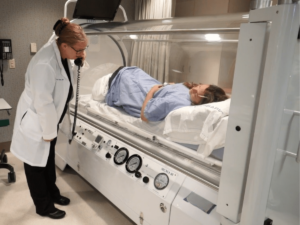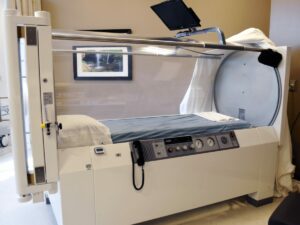Is anyone familiar with the profound advantages of Hyperbaric Oxygen Therapy (HBOT) but hesitant due to its perceived expenses? Navigating the HBOT landscape necessitates a grasp of the financial aspects involved. Myths and misconceptions about the cost can become obstacles to embracing this transformative therapy.
This article presents a detailed overview of the HBOT session costs and the elements that shape them. The aim is to equip individuals with the knowledge to make sound decisions, ensuring optimal treatment without excess expenditure.
Financial stability is as paramount as health; hence, let’s explore this subject to manage both adeptly.
1. Understanding Hyperbaric Oxygen Therapy
According to Food and Drug Administration, HBOT involves breathing 100% (pure) oxygen while in a special space called a hyperbaric chamber. The air pressure inside is raised to a level that is higher than normal air pressure. The heightened pressure boosts oxygen saturation, accelerating healing and promoting efficient recovery. This approach leverages oxygen’s healing power, offering benefits for various medical conditions.
When under pressure, oxygen’s solubility in the bloodstream is significantly improved, allowing it to circulate more efficiently throughout the body. This enhancement, crucial for therapy, amplifies natural healing by reducing inflammation and promoting the release of growth factors and stem cells. Remember, utilizing the unique properties of oxygen under pressure can be a game-changer in the healing journey.
HBOT is employed to manage a variety of conditions, including diabetic foot ulcers, decompression sickness, burns, carbon monoxide poisoning, and even some types of brain injuries. And now, you’re thinking, it’s truly remarkable how this therapy has become an increasingly popular adjunctive treatment in various medical specialties.
2. Factors Affecting the Cost of Hyperbaric Oxygen Therapy
Having established a foundational understanding of HBOT, the focus now shifts to the factors that shape the cost of a therapy session. The ensuing discussion illuminates the chief elements that dictate the financial commitment for this treatment. The following sheds light on the principal elements influencing cost:
The Type of Facility (Hospital or Private Clinic)
The venue selected for hyperbaric therapy plays a pivotal role in determining the treatment’s financial aspect:
- Hospitals: Given their extensive infrastructural and administrative needs, hospitals typically carry heftier operational burdens. Consequently, patients might encounter elevated hyperbaric treatment costs within such settings.
- Private Clinics: Benefiting from an optimized operational structure, private clinics typically maintain lower overheads. This streamlined approach positions them to offer hyperbaric treatments at a notably cost-effective rate, often making them a preferred choice for budget-conscious patients.

Geographical Location
From my own observations and interactions, the region in which the treatment facility is located can also influence the cost. In areas where the cost of living is higher, the costs for healthcare services, including hyperbaric therapy, will likely be more expensive than in areas with a lower cost of living.

Session Duration
The length of each hyperbaric session can affect the cost. Longer sessions may require more oxygen, electricity, and personnel time, thereby increasing the cost. According to National Institutes of Health. Typically, treatments involve pressurization to between 2.0 and 2.5 ATA for periods between 60 and 120 minutes once or twice daily for a total of 30 to 60 sessions of treatment.

The Condition Being Treated
Navigating the complexities of Hyperbaric Oxygen Therapy (HBOT) costs requires a deep understanding of its various conditions. A primary factor shaping these expenses is the specific medical condition being addressed:
- The specific nature of the condition: Different ailments or injuries may have unique treatment protocols. The tailored approach at OxygenArk ensures that each condition, whether it’s a wound healing process or decompression sickness, receives the most suitable treatment plan.
- Severity or complexity of the ailment: More intricate or severe cases often require extended treatment durations or more frequent sessions, reflecting a deeper commitment to therapeutic intervention. This comprehensive approach, while ensuring optimal patient care, can influence the overall financial investment in the treatment process.
Type of Hyperbaric Chamber Used
Hyperbaric chambers, pivotal in delivering oxygen therapy, come in various designs tailored to diverse clinical needs. For instance:
- Mono-place Chambers: Designed for individual patient use, these chambers exclusively deploy 100% oxygen. Owing to their specialized design, they demand the utmost in material quality for unmatched safety. Moreover, their precision engineering ensures consistent and effective therapeutic results.
- Multi-place Chambers: Tailored to accommodate multiple patients simultaneously, these chambers typically employ regular air as their primary atmosphere. Oxygen is then precisely administered to the patients via masks or hoods, ensuring a controlled and efficient delivery. This setup maximizes the chamber’s capacity while maintaining the effectiveness of the therapy.

Individual Practitioner’s Fees
From my own experience, I’ve noticed that medical fees can vary considerably based on the practitioner’s expertise, experience, and reputation. The cost can also be influenced by the fees of the healthcare professionals involved. Practitioners with more experience or specialized expertise may charge higher fees.
Additional Services and Amenities
When assessing the overall cost of HBOT, it’s vital to factor in various supplementary services provided by facilities. These offerings not only enhance the patient experience but can also impact the final bill:
- Patient Transportation: Some facilities offer transportation services, ensuring patients arrive for their treatments safely and on time. This convenience is especially valuable for those who may have mobility challenges or lack reliable transportation.
- Personal Care Assistance: Personalized care, such as assistance with mobility, feeding, or medication during treatment, can be provided. This attentive service ensures that the patient remains comfortable and well-cared-for throughout their HBOT journey.
- Specialized Amenities: Luxuries like private rooms, entertainment options, or meals catered to specific dietary needs can be available. These amenities aim to make the HBOT experience as pleasant and stress-free as possible.
- Enhanced Nursing Care: Some patients may require a higher level of nursing attention, whether due to the nature of their condition or coexisting health challenges. This intensive care ensures their safety and comfort during the treatment process.
- Advanced Monitoring during Treatment: Using state-of-the-art equipment and techniques, certain facilities offer real-time monitoring of patient’s vital signs and overall well-being during HBOT. This continuous observation ensures immediate response to any potential concerns.
3. Average Cost Per Session: An Overview
The ‘Average Cost Per Session’ summarizes what patients may pay per HBOT session, factoring in treatment costs, regional pricing variations, expense breakdowns, and potential insurance coverage. Below, we will delve into specifics, discussing costs in different regions, itemized expenses, and insurance considerations:
Cost Ranges in Different Countries and States
Hyperbaric oxygen therapy costs differ based on the treatment center’s location, with prices typically higher in countries with a higher cost of living or advanced healthcare systems. Within countries, especially larger ones like the U.S., costs can differ considerably between states. For instance, treatment in urban centers might cost more than in rural areas due to operational expenses and demand.
Breakdown of Expenses (Consultation, Treatment, Equipment)
When one assesses the comprehensive billing for an HBOT session, it’s essential to realize that this sum is a combination of various distinct charges. From initial consultations to the utilization of state-of-the-art equipment, every element plays its role in determining the overall expenditure. Here’s a detailed breakdown:
- Consultation Fees (Approximately $50 – $250): Before embarking on the HBOT journey, patients meet with seasoned medical experts for a preliminary assessment. This consultative stage, which determines the appropriateness and nuances of the therapy, comes with its associated fee. It’s pivotal to understand that this initial cost is more than just a procedural formality; it paves the way for a specialized, patient-centric therapeutic strategy.
- Treatment Costs (Approximately $200 – $1,200 per session): The heartbeat of HBOT expenditure resonates with the real-time treatment. Each therapeutic session within the sanctity of the hyperbaric chamber represents a major chunk of the holistic expense. Multiple variables, from the session’s duration and frequency to the intricacies of the patient’s health status, influence this cost bracket.
- Equipment Expenses (Approximately $20 – $100 per session): HBOT isn’t just about the treatment; it’s equally about the tools that facilitate it. The cost associated with the hyperbaric chamber and related apparatus can substantially impact the total expense. Factors like the technological prowess of the equipment, its maintenance, and the inherent features it offers to play a decisive role in sculpting this segment of the cost.
Insurance Coverage and Eligibility for HBOT
While HBOT is recognized as a valid treatment for several medical conditions, not all treatments might be covered by insurance. The eligibility largely depends on the diagnosis and the insurance provider’s policies. Some insurers cover HBOT for conditions like diabetic foot ulcers and decompression sickness, while others might only cover it under specific circumstances or after certain pre-treatments have been attempted.
Please note that the information provided in the table is a general overview and might not reflect specific insurance policies or coverage details for every individual case. Eligibility and coverage for HBOT can vary widely depending on the insurance provider, medical condition, and other factors. It’s important to consult with your healthcare provider and insurance company for accurate and up-to-date information regarding HBOT coverage and eligibility.
| Medical Condition |
Insurance Coverage for HBOT |
Eligibility Criteria |
Coverage Notes |
| Diabetic Foot Ulcers |
Covered |
Typically covered if standard wound care has failed. |
Coverage may require documentation of wound severity and failed prior treatments. |
| Decompression Sickness |
Covered |
Generally covered as part of emergency medical care. |
Immediate treatment often required, coverage details may vary. |
| Carbon Monoxide Poisoning |
Covered |
Generally covered as emergency treatment. |
Often covered due to the urgent nature of the condition. Coverage may depend on severity and confirmation of exposure. |
| Non-Healing Wounds |
Variable Coverage |
May be covered based on wound severity. |
Insurers may require documentation of failed conventional treatments and wound healing progress. |
| Radiation Injury |
Limited Coverage |
Coverage may depend on the extent of injury. |
Some insurers may require evidence of radiation-induced injury and failure of standard treatments. |
| Thermal Burns |
Limited Coverage |
Coverage may be considered for severe burns. |
Eligibility may involve assessment of burn depth and extent, along with failed attempts at conventional burn care. |
| Chronic Osteomyelitis |
Variable Coverage |
Coverage may be considered after failed treatment. |
Documentation of failed conventional treatment and evidence of persistent infection may be required. |
| Gas Gangrene |
Limited Coverage |
Coverage may depend on severity and treatment. |
Insurers may require confirmation of diagnosis and potential need for HBOT as part of comprehensive treatment plan. |
| Radiation Necrosis |
Limited Coverage |
Often covered for specific cancers and locations. |
Eligibility might involve documentation of radiation treatment history, tumor location, and potential benefits of HBOT. |
| Crush Injuries |
Limited Coverage |
Coverage may depend on severity and treatment. |
Insurers may consider coverage based on the extent of tissue damage, failed treatments, and potential for improved healing with HBOT. |
4. Financing Options for HBOT
Financing options for HBOT encompass different methods that patients can use to manage their treatment costs. Considering the diverse global costs of HBOT, these options, including health financing programs, medical loans, payment plans, and crowdfunding, can lessen financial strain and increase treatment accessibility. Let’s explore some of the avenues:
Health Financing Programs
Health financing programs, established by governments or private entities, assist in covering medical costs, including HBOT. The coverage depends on the program and individual eligibility, varying from partial to full costs, with options differing across countries and the role of private insurance. Always remember to explore these options thoroughly, as they can significantly reduce the out-of-pocket expenses.
Medical Loans and Payment Plans
Medical loans, obtained from financial institutions, and payment plans offered by healthcare providers are viable options for financing HBOT, enabling manageable payments over a specified period. At OxygenArk, we understand the financial implications of HBOT and are committed to assisting our patients in finding suitable financing options.
Crowdfunding and Community Support
In recent years, crowdfunding and community support have become increasingly popular methods of financing medical treatments. Crowdfunding websites like GoFundMe, along with local community aid, provide fundraising avenues for medical expenses, especially beneficial for those lacking other financing options. Remember, every little bit helps, and there’s a vast community out there ready to support this health journey.

5. 4 Tips for Reducing Hyperbaric Oxygen Therapy Costs
Navigating the costs of Hyperbaric Oxygen Therapy (HBOT) can be challenging. However, there are strategies to help reduce these expenses, making therapy more affordable. The following sections provide tips on how to potentially lower HBOT costs:
#1 Exploring Local Facilities and Options
Variations in HBOT costs across different facilities often result from factors such as location, staff expertise, and equipment quality. Exploring local options can reveal facilities offering treatment at more affordable rates, all while maintaining high standards of quality. Keep in mind, the cheapest option is not always the best-balanced cost with quality care.
#2 Seeking Financial Assistance Programs
Various public and private organizations offer financial assistance programs for medical treatments. These may take the form of grants, subsidies, or coverage plans that can help offset the cost of HBOT. Applying to these programs requires diligence, but the potential savings are significant. Remember, every bit of assistance can help lighten the financial load of treatment.
#3 Negotiating With Healthcare Providers
Surprisingly, healthcare costs are often negotiable. Engaging in an open dialogue about financial situations with healthcare providers can lead to adjustments in treatment costs. These can take several forms:
- Discounted Rates: Providers might be open to offering services at discounted rates, particularly when a patient’s financial constraints are openly expressed. This flexibility can make a significant difference in making the treatment more accessible.
- Payment Plans: Instead of demanding the full amount upfront, some providers may suggest a payment plan, spreading the cost over an agreed period. This arrangement can ease the financial burden, allowing the patient to focus more on their recovery.
- Waiving or Reducing Additional Fees: In certain scenarios, providers might consider waiving or reducing additional fees. These could be fees associated with initial consultations or follow-up visits, further lessening the financial strain on the patient.
- Sliding Scale Pricing: A number of providers operate on a sliding scale basis, adjusting the cost of treatment relative to the patient’s ability to pay. This approach ensures that the cost aligns with the patient’s income level, fostering a fairer payment system.
- Free or Discounted Services: Some providers may extend free or discounted ancillary services, such as physical therapy or counseling. These additional offerings can complement the main treatment regimen, maximizing the patient’s overall well-being without incurring extra costs.
- Package Deals: Particularly with treatments like HBOT that require multiple sessions, providers might offer package deals. In these arrangements, booking several sessions at once comes at a lower total cost. This can result in significant savings compared to paying for each session separately. Securing a package deal aids financial planning and promotes regular treatment, optimizing therapy effectiveness.
#4 Bundled Treatment Packages and Discounts
Some facilities may offer bundled treatment packages or discounts. For instance, a clinic might provide a package where booking ten sessions of HBOT upfront costs less than booking and paying for each session individually. This arrangement can significantly reduce the total cost, making therapy more affordable. Booking sessions upfront ensures consistent treatment, boosting therapy effectiveness.
Conclusion
In conclusion, understanding the cost per session of Hyperbaric Oxygen Therapy (HBOT) is crucial in ensuring that you or your clients are well-prepared for the financial obligations it entails. This guide has endeavored to provide a comprehensive overview of the many factors that influence the cost of this therapy. From the type of facility to the specific condition being treated, a broad spectrum of elements come into play.
Contact us at OxygenArk today to learn more about our cost-effective and high-quality HBOT chambers. As manufacturers, we understand the intricacies of the industry and can provide insights into reducing the costs associated with this valuable treatment. Your journey to understanding and providing HBOT starts here. Let’s walk this path together.





